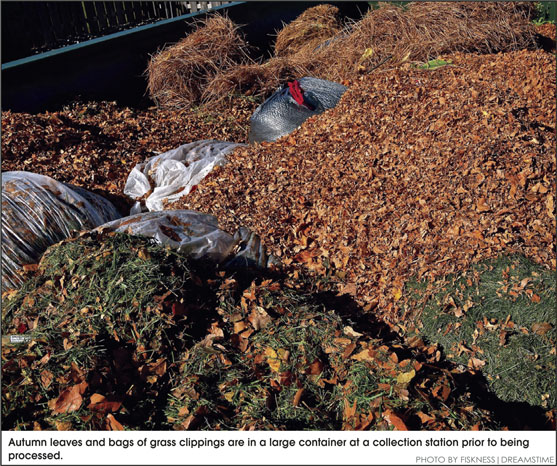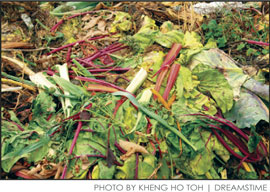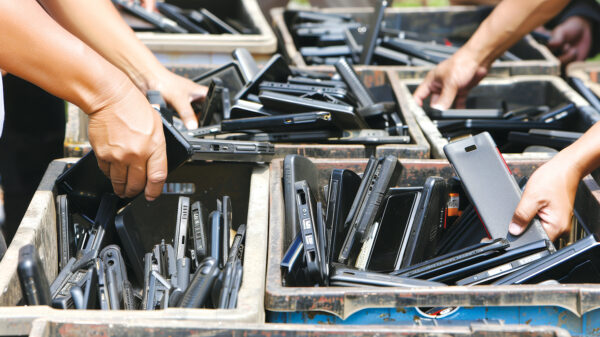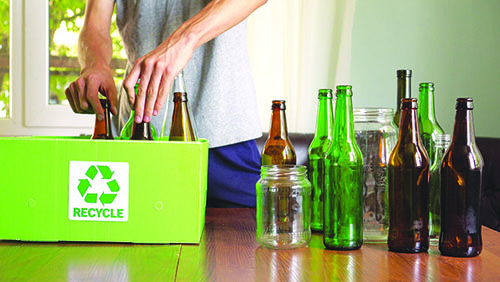by MAURA KELLER
According to Ryan Battles, digital strategist at WasteBits, one of the largest digital waste profiling software companies, most communities with a curbside service program provide an additional yard waste pickup day, but food waste continues to mingle with the general household waste.

“A growing number of cities across the U.S. are implementing dedicated curbside food waste collection programs, but continued adoption is challenging due to a number of factors that must be considered before a community can adopt a food waste program,” Battles said.
First of all, as Battles explained, a community must be able to develop an infrastructure of haulers, either by leveraging existing haulers or contracting with new ones. In addition, a suitable location to collect and process organic waste should be within a reasonable distance.
“If none is available, the cost to develop such a facility must be considered,” Battles said. “All of these factors are then compared to the regional cost for waste at the local landfills. The higher the cost of disposing of waste at the local landfill, the easier it is to justify the cost of a community food waste composting program.”
One of the biggest challenges to organic waste recycling is contamination by non-organic material. “When the sorting process is left to the consumer, general waste and recyclables can be intermingled with the organic waste, leading to a mixture of waste that can neither be recycled nor composted,” Battles said.
Ryan Cooper, waste diversion manager and organics recycling lead at Rubicon, said different municipalities handle their food and yard waste in different ways because of a number of factors: landfill diversion goals, cost, infrastructure and knowledge being four key considerations.
“Jurisdictions have differing goals, access to capital, existing private and/or public infrastructure, and skills to create organics recycling solutions,” Cooper said. “Food waste collection for animal feed and other uses was common in some areas in the past, but has not been seen in most communities for generations. Many municipalities handle yard waste by composting and/or mulching the material because the level of permitting is relatively low and the material is easier to handle than food scraps or biosolids. Composting food waste and biosolids requires more permitting and tighter management. Mulch yards run the risk of fires, but composting facilities draw criticism because of odor if they are not managed correctly.”
As Cooper explained, more and more jurisdictions are moving away from landfilling or incinerating valuable resources such as yard waste, food waste and biosolids because of waste diversion goals. In fact, many municipalities are adding food waste and fats, oils and greases (FOG) to existing anaerobic digesters at their wastewater treatment plants (WWTPs – now called water resource recovery facilities – WRRFs).
“Municipalities are adding digester capacity and depackaging capability as well,” Cooper said. “Private firms are also steadily increasing the number of composting and anaerobic digestion facilities in conjunction with depackaging infrastructure that can separate organics from packaging like plastic or metal.”
Innovations Aplenty
Industry players such as municipalities, haulers, designers, builders and operators also have varied levels of interest in organics recycling. As Cooper explained, many industry folks and venture capitalists are excited about the opportunity and others are more reluctant. Many are specialized organics recycling companies, but larger haulers and cities are getting in the game as well.
“Separation of materials into MSW, SSR and organics is becoming the norm in more progressive areas, while there are still many parts of the country with little to no infrastructure or recycling culture to drive these programs,” Cooper said.
Faster, more efficient methods of composting organic waste are being developed and tested in order to reduce costs and improve turnaround time.
As Battles explained, some of the key biological innovations that help handle organic waste include:
•Anaerobic Digestion Systems – closed systems that process waste in an oxygen-depleted environment
•Thermal Hydrolysis – high-pressure boiling of waste followed by rapid decompression
•Food Waste to Water – nutrient-neutral water is created by aerobic bacteria and released safely into the sewer
Non-biological innovations include:
•Food Waste Pulpers and Shredders – waste is shredded, then water extracted to provide compost feedstock
•Food Waste Dehydration – heat and agitation evaporate moisture out, remaining pulp used as compost feedstock or potentially as animal feed or fertilizer
•Pyrolysis – thermo-chemical decomposition at high temperatures without oxygen
“The challenge of building infrastructure is creating a bottleneck that restricts the implementation of programs and hauling,” Cooper said. Contamination, because of lack of training and education, is also a huge challenge.
Many organizations are resorting to machines that can remove contaminants on the front end of the processing facility. “Pricing to the consumer and municipality is always an issue because of both the cost to build and operate organics recycling facilities as well as new trucks, drivers, and other equipment,” Cooper said.
Costs aside, Cooper pointed to many new technologies that are becoming more important as time goes on. For example, inside kitchens and cafeterias, technology is being developed to help businesses determine how much food waste they are generating in the first place, which can help them make better ordering decisions or ensure that items are used in other dishes instead of being discarded.
“Food packaging is constantly changing – because of pushback on certified compostable foodservice ware, foodservice operators are looking at solutions like reusables,” Cooper said. “Dehydration, aerobic digestion, shredding and other on-site preprocessing technologies have the potential to change the industry. Depackaging technology is changing the way that facilities deal with contamination and also the mix of materials that ultimately wind up as animal feed, compost, or biogas. Other technologies are creating new products that can be converted from wasted food and other organics.”
C&D Organic Waste
Recyclable waste from construction and demolition (C&D) activity varies widely, but one thing’s for sure: there is a tremendous amount of organic waste, specifically wood waste that can be recycled and put to use in a variety of ways.
Chris Batterson, account manager, construction & demolition recycling division at Rubicon, said that traditionally, the organic waste coming from a C&D project would be wood – whether as dimensional lumber or pallets.
As Batterson explained, dimensional lumber, which is uncoated but has odd lengths and sizes in scrap form, makes it difficult for any reuse or repurpose needs. It is instead recycled for wood chips, mulch, particleboard, and chipboard being the most frequent applications.
“It can also be used for biomass fuel, but currently that is a hot topic among the sustainability community and certification providers as to whether or not that is truly diversion,” Batterson says. At Rubicon, they focus on two other materials on every project that fall under the organics category. Gypsum, which today mainly ends up in the landfill is one focus for Rubicon. Utilizing the company’s organics network they are able to get this material to composters and farmers to utilize in their soil at a lower cost than landfill or even in some cases, to sell it as a commodity to that network.
“We still work on closed loop solutions for gypsum where possible, but the infrastructure just does not exist today nationwide, and the costs for freight along with the GHG emissions associated with that long distance trucking make it hard to justify as a benefit,” Batterson said.
Down the Road
There is a history of banning yard waste from the landfill, and already multiple U.S. cities and states have passed regulations that encourage or require diversion of food scraps from the landfill. So what does this mean for the future of organic waste?
“As the industry is becoming more aware of the issues surrounding organic waste recycling, there has been an influx of legislation and regulation,” said Matthew Hollis, co-founder/president of Elytus, a waste management company that uses technology to help clients receive better waste removal services and become more sustainable in the process. “Part of the challenge is that these laws mandate organic waste recycling, yet do not facilitate the infrastructure to do it. This disjunction between policy and pragmatism has left the industry in a scurry to build out the infrastructure to comply.”
Whenever there’s an inefficient process, there exists a large opportunity for innovation. Hollis and his team at Elytus is seeing advancements in dehydrators, digestors and grinding programs that transform the organic waste into a slurry.
“The extent to which these technologies can take off may depend on how much impact they have on the bottom line,” Hollis said.
As beneficial use of organics like food waste and biosolids increases, more and more infrastructure will be created. However, as Cooper pointed out, it is very much a case of the chicken and the egg.
“Jurisdictions pass regulations that encourage organics recycling and then the industry and affected generators scramble to keep up. As soon as they do, new phases of regulations start the process all over again. Places that consider these types of initiatives important will continue passing more and more progressive rules, while areas that do not consider this a priority will not,” Cooper said. “This creates an uneven playing field for generators, haulers, and processors alike. Business and consumers that travel from place to place will continue to be bewildered by organics recycling programs that vary based on location. As more municipalities and private companies pass organic waste regulations, develop infrastructure, and educate the citizenry about organics recycling, residents and businesses will continue to adopt the practice of separating these materials to create valuable products such as fertilizer, energy and fuel.”
Published in the January 2020 Edition







